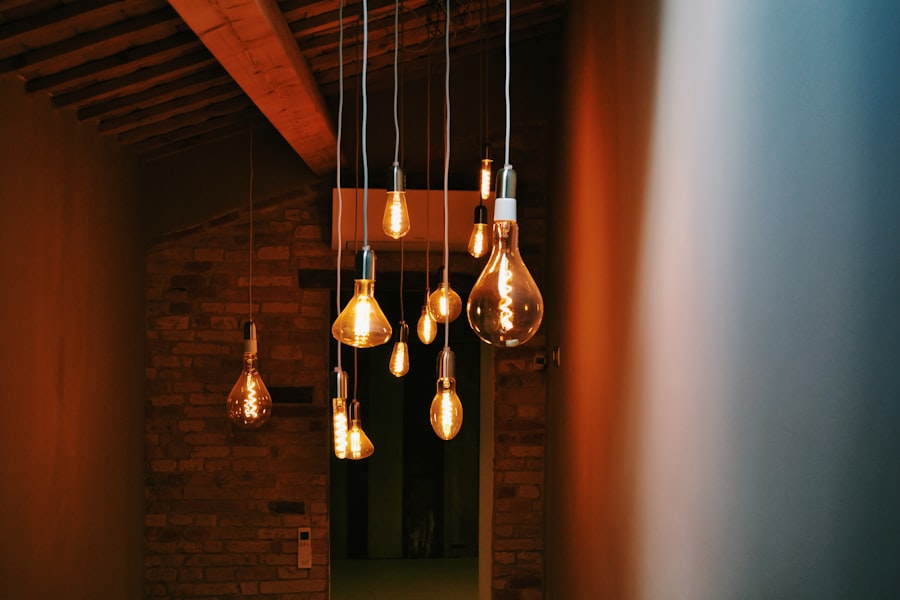Growing Ranunculus Bulbs: Tips for Success

The ranunculus bulb, also known as the Persian buttercup, is a popular flower bulb that is native to Asia and Europe. It has a long and rich history, dating back to ancient times. The bulb was highly prized for its vibrant and colorful flowers, which were often used in religious ceremonies and celebrations.
The ranunculus bulb is characterized by its small, round shape and papery outer layer. It is typically planted in the fall and blooms in the spring, producing a wide range of colors including red, pink, yellow, orange, and white. The flowers have multiple layers of petals, giving them a full and ruffled appearance.
Key Takeaways
- Ranunculus bulbs are a popular choice for gardeners due to their vibrant colors and easy care.
- Choose a location with well-draining soil and full sun for the best results.
- Prepare the soil by adding compost and ensuring proper drainage.
- Plant the bulbs in the fall, with the pointed end facing up and about 2-3 inches deep.
- Water regularly and fertilize every few weeks to promote healthy growth.
Choosing the Right Location for Your Ranunculus Bulbs
When it comes to growing ranunculus bulbs, choosing the right location is crucial for their success. These bulbs thrive in cool climates with mild winters and moderate temperatures. They prefer temperatures between 50-60 degrees Fahrenheit (10-15 degrees Celsius) during the day and slightly cooler temperatures at night.
In terms of sunlight requirements, ranunculus bulbs need full sun to partial shade. They should be planted in an area that receives at least 6-8 hours of direct sunlight each day. However, they can also tolerate some shade, especially during the hottest part of the day.
Ranunculus bulbs require well-draining soil to prevent waterlogged conditions that can lead to root rot. They prefer sandy or loamy soil that is rich in organic matter. If your soil is heavy clay or compacted, you may need to amend it with organic matter such as compost or peat moss to improve drainage.
Preparing the Soil for Planting Ranunculus Bulbs
Before planting your ranunculus bulbs, it’s important to prepare the soil properly to provide optimal growing conditions. Start by testing your soil to determine its pH level and nutrient content. Ranunculus bulbs prefer slightly acidic soil with a pH between 6.0 and 6.5.
Based on the results of your soil test, you may need to amend the soil with fertilizers or organic matter to provide the necessary nutrients for the bulbs. A balanced fertilizer with equal amounts of nitrogen, phosphorus, and potassium is generally recommended for ranunculus bulbs.
In terms of soil preparation techniques, start by removing any weeds or grass from the planting area. Loosen the soil with a garden fork or tiller to a depth of at least 8-10 inches. Mix in any necessary amendments, such as compost or peat moss, to improve drainage and fertility.
Planting Ranunculus Bulbs: Step-by-Step Guide
| Step | Description |
|---|---|
| 1 | Choose a planting location with well-draining soil and full sun exposure. |
| 2 | Prepare the soil by removing any weeds or debris and adding compost or fertilizer. |
| 3 | Plant the ranunculus bulbs 2-3 inches deep and 4-6 inches apart. |
| 4 | Water the bulbs thoroughly after planting and keep the soil moist but not waterlogged. |
| 5 | Apply a layer of mulch to help retain moisture and suppress weeds. |
| 6 | Monitor the bulbs for signs of growth and water as needed. |
| 7 | Once the flowers have bloomed, deadhead them to encourage more blooms. |
| 8 | After the foliage has died back, dig up the bulbs and store them in a cool, dry place until the next planting season. |
Timing is crucial when it comes to planting ranunculus bulbs. They should be planted in the fall, about 6-8 weeks before the first frost date in your area. This allows the bulbs to establish their root system before winter sets in.
When planting ranunculus bulbs, space them about 4-6 inches apart and plant them at a depth of 2-3 inches. If you are planting multiple bulbs, you can create a trench and place them in rows for a more organized look.
After placing the bulbs in the holes, cover them with soil and gently firm it down to eliminate any air pockets. Water the area thoroughly to settle the soil and provide moisture for the bulbs.
Watering and Fertilizing Ranunculus Bulbs
Proper watering is essential for the healthy growth of ranunculus bulbs. They require regular watering, especially during dry periods or when they are actively growing. Aim to keep the soil consistently moist but not waterlogged.
The frequency and amount of water needed will depend on your climate and soil conditions. In general, ranunculus bulbs should be watered deeply once or twice a week, providing about 1 inch of water each time. However, it’s important to monitor the soil moisture and adjust your watering schedule accordingly.
When it comes to fertilizing ranunculus bulbs, a balanced fertilizer can be applied in early spring when new growth appears. Follow the instructions on the fertilizer package for the recommended application rate. Avoid over-fertilizing, as this can lead to excessive foliage growth at the expense of flower production.
Protecting Ranunculus Bulbs from Pests and Diseases

Ranunculus bulbs are generally resistant to pests and diseases, but they can still be susceptible to certain issues. Common pests that may affect ranunculus bulbs include aphids, slugs, and snails. These pests can be controlled through various methods such as handpicking, using organic insecticides, or creating physical barriers.
Diseases that can affect ranunculus bulbs include root rot, powdery mildew, and botrytis blight. To prevent these diseases, it’s important to provide proper drainage and avoid overwatering. Good air circulation around the plants can also help prevent fungal diseases.
If you notice any signs of pests or diseases on your ranunculus bulbs, it’s important to take action immediately. Early detection and intervention can help prevent the spread of the problem and minimize damage to the plants.
Supporting Ranunculus Stems as They Grow
As ranunculus plants grow, their stems may become tall and top-heavy, making them prone to bending or breaking. To prevent this, it’s important to provide support for the stems.
There are several types of support structures that can be used for ranunculus stems. One option is to use stakes or bamboo poles placed around the plants and tied with twine or plant ties. Another option is to use a wire cage or plant support ring that can be placed over the plants to provide support.
When tying or training the ranunculus stems, be gentle to avoid damaging the plants. Use soft ties or twine that won’t cut into the stems as they grow. Regularly check the plants and adjust the ties as needed to accommodate their growth.
Harvesting Ranunculus Flowers
Ranunculus flowers are typically ready for harvest in the spring, when they are fully open and the petals are vibrant and colorful. The timing of the harvest will depend on the variety and growing conditions, but it’s generally best to wait until at least half of the flowers on a stem have opened.
To harvest ranunculus flowers, use a sharp pair of scissors or garden shears to cut the stems at an angle, about 1 inch above the base of the plant. Place the cut stems in a bucket of water immediately to keep them hydrated.
It’s important to handle the harvested ranunculus flowers with care to avoid damaging the delicate petals. Remove any leaves or foliage that will be submerged in water to prevent bacterial growth. Change the water in the vase every few days to keep the flowers fresh.
Storing Ranunculus Bulbs for the Next Season
After the ranunculus flowers have finished blooming, it’s time to dig up and clean the bulbs for storage. Wait until the foliage has turned yellow and died back before digging up the bulbs.
To dig up the bulbs, use a garden fork or shovel to carefully loosen the soil around them. Gently lift them out of the ground, being careful not to damage them. Shake off any excess soil and remove any dead or damaged bulbs.
Once the bulbs have been cleaned, they should be stored in a cool, dry place until it’s time to plant them again in the fall. A cardboard box or mesh bag can be used for storage, as long as it provides good airflow. Avoid storing bulbs in plastic bags, as this can cause them to rot.
Troubleshooting Common Problems with Growing Ranunculus Bulbs
While ranunculus bulbs are generally easy to grow, they can still face certain issues. One common problem is poor flower production, which can be caused by factors such as insufficient sunlight, overwatering, or nutrient deficiencies. To address this issue, make sure the bulbs are planted in a sunny location, water them properly, and provide adequate fertilization.
Another common problem is bulb rot, which can be caused by overwatering or poor drainage. To prevent bulb rot, make sure the soil is well-draining and avoid overwatering. If you notice any signs of rot, such as soft or mushy bulbs, remove and discard the affected bulbs to prevent the spread of the disease.
It’s important to address any problems with growing ranunculus bulbs as soon as possible to prevent further damage and ensure healthy growth and flower production. Regular monitoring and proper care can help prevent many common issues and promote the success of your ranunculus bulbs.
If you’re looking to learn how to grow ranunculus bulbs, you’ll definitely want to check out this informative article from Lawn World. They provide a step-by-step guide on cultivating these beautiful flowers, ensuring that you can enjoy their vibrant colors in your garden. From choosing the right location to planting and caring for the bulbs, this article covers it all. To get started on your ranunculus-growing journey, click here: https://www.lawnworld.com/how-to-grow-ranunculus-bulbs.html.
FAQs
What are ranunculus bulbs?
Ranunculus bulbs are small, round bulbs that produce beautiful, brightly colored flowers. They are commonly used in gardens and as cut flowers.
When should I plant ranunculus bulbs?
Ranunculus bulbs should be planted in the fall, typically between September and November, depending on your climate. This allows them to establish roots before the winter and bloom in the spring.
Where should I plant ranunculus bulbs?
Ranunculus bulbs should be planted in a location that receives full sun or partial shade. They prefer well-draining soil and should be planted about 2-3 inches deep.
How often should I water ranunculus bulbs?
Ranunculus bulbs should be watered regularly, but not overwatered. They prefer moist soil, but too much water can cause the bulbs to rot. Watering once or twice a week should be sufficient.
How do I care for ranunculus bulbs after they bloom?
After the ranunculus flowers have bloomed, allow the foliage to die back naturally. This allows the bulbs to store energy for the next growing season. Once the foliage has died back, the bulbs can be dug up and stored in a cool, dry place until the next planting season.



